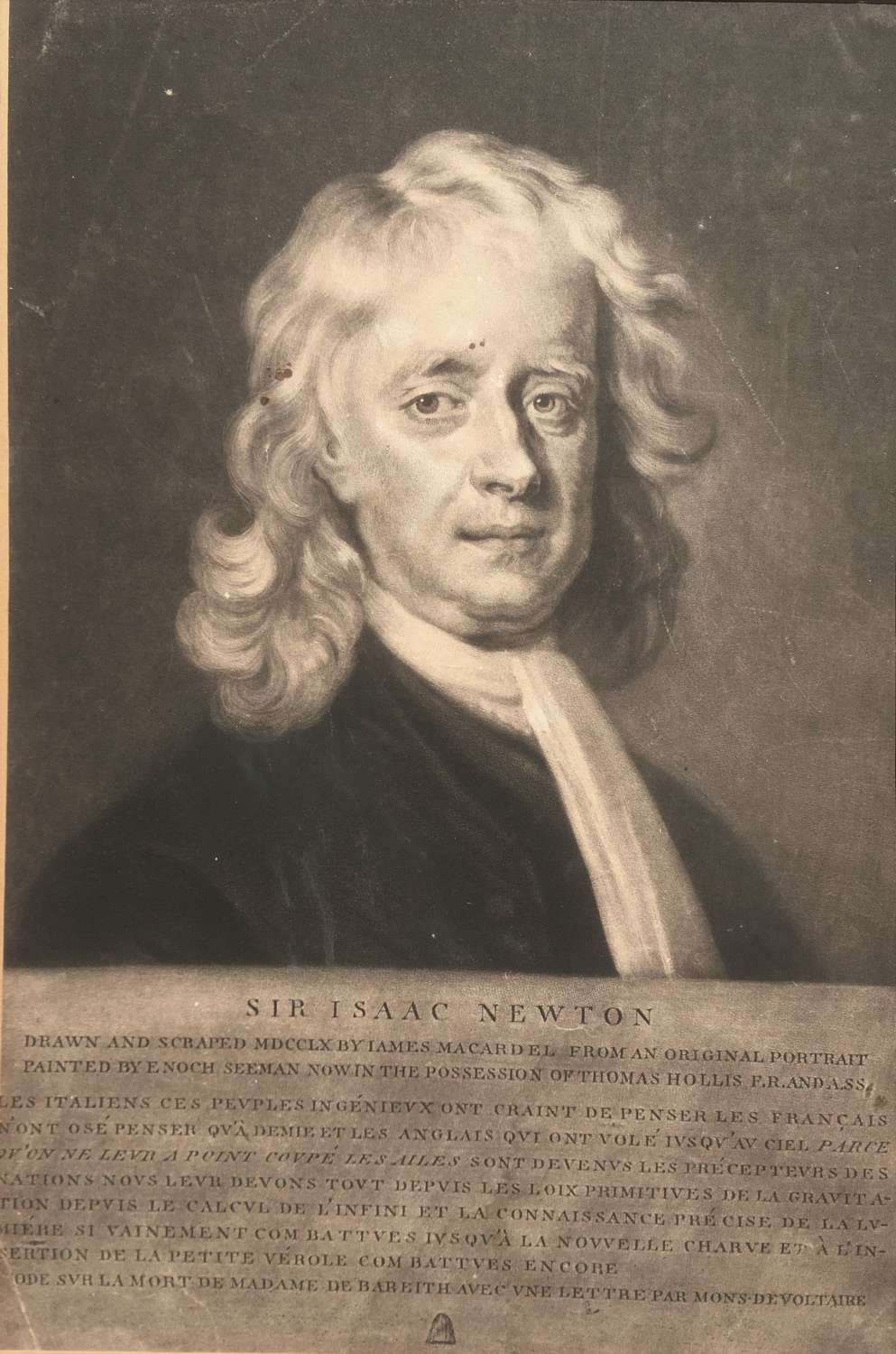
Code: 10182
Dimensions:
Sir Isaac Newton (1643-1727)
Mezzotint Portrait, 1760
By James McArdell (1729-1765) after Enoch Seeman (1694-1744)
Early state before highlighted button and lightening of the ground
Dimensions: 268 mm x 173 mm
The text beneath the image reads "Drawn and Scraped MDCCLX by Iames Macardel from an Original Portrait Painted by Enoch Seeman now in the Possession of Thomas Hollis F.R. and A.S.S.", with a quotation in French from Voltaire's 1759 work "Ode sur la mort de Madame de Bareith" which comments on the scientific achievements of the English: "Les Italiens ces peuples ingénieux ont craint de penser les Français n'ont osé penser qu'à demie et les Anglais qui ont volé iusqu'au ciel parce qu'on ne leur a point coupé les ailes sont devenus les précepteurs des nations depuis le calcul de l'infini et la connaissance précise de la lumiére si vainement combattues iusqu'à la nouvelle charue et à l'insertion de la petite vérole combattues encore" [The Italians, those ingenious people, feared to think: the French only dared to half-think and the English, who flew to the sky because we did not clip their wings, became the tutors of the nations since they have calculated the infinite and gained precise knowledge of the light and ploughed their own furrow against disease], with the reference "Ode sur la mort de Madame de Bareith avec une lettre par Mon. de Voltaire". Below the text is a small illustrated remarque of a Phrygian "Liberty Cap".
The "Thomas Hollis F.R. and A.S.S." mentioned on the print is Thomas Hollis (1720–1774). The Hollis family originated in Rotherham but, being of non-conformist persuasion had settled in the dissenting enclave of Minories in London where they accumulated a great fortune through the wholesale trade of "Sheffield Goods" (cutlery and hardware). As dissenters the Hollis family showed substantial benefaction to Harvard College, Cambridge, Massachusetts, New England, especially in the form of money and books. Hollis's great uncle (also Thomas Hollis (1659-1731)) was Harvard's most generous 18th-Century benefactor, endowing chairs in his family's name for Divinity (in 1721) (the oldest endowed chair in the United States) and (as an equivalent to the Lucasian Chair of Mathematics at Cambridge, England) of Mathematics and Natural Philosophy (in 1727). Thomas Hollis's father (also, confusingly, named Thomas Hollis) had been the sole executor of his uncle Thomas' will. The Hollis's support for scholarship in the American Colonies ultimately became, for the youngest Thomas Hollis, a firm conviction that it would be best for America if it became an independent republic. From 1760, the year this mezzotint's publication, Thomas Hollis commissioned and circulated various works which advocated republicanism and the small Phrygian "Liberty Cap" beneath the text on the print is a discreet symbolic reference to Hollis's ideas. Hollis presented his portrait of Newton to Trinity College Cambridge in 1761. This bust-length portrait of Newton, which was painted by Enoch Seeman in 1726, is considered to be one of the primary likenesses of one of the most important figures in the formation of modern scientific understanding.
Bibliography
See No. 78; Page 67 of Gordon Goodwin "British Mezzotinters: James McArdell", A. H. Bullen, London, 1903
P.32-33 of Milo Keynes "The Iconography of Sir Isaac Newton to 1800", Boydell Press, Woodbridge, Suffolk, 2005